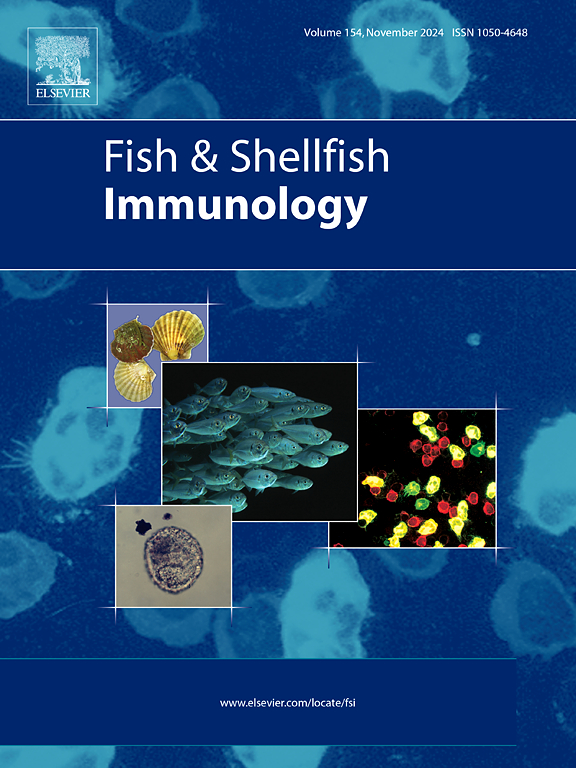饲料中烟酸对饲喂高脂饲料的大比目鱼幼鱼(Scophthalmus maximus L.)的肠道保护作用:调节粘膜免疫反应、屏障功能和肠道微生物群
IF 3.9
2区 农林科学
Q1 FISHERIES
引用次数: 0
摘要
本研究探讨了饲料中烟酸对高脂饲料(HLD)喂养的大菱鲆幼鱼肠道健康的保护作用。配制两种等氮等脂饲料,包括不添加烟酸(HL0)的HLD和添加80 mg/kg烟酸(HL80)的HLD。大比目鱼(约13.2 g)投喂两种试验饲料,饲喂10周,每种饲料分配到3个重复槽中。结果表明,烟酸显著提高了大菱鲆的增重率和特定生长率。饮食中的烟酸显著下调toll样受体(TLRs)及其相关信号成分的表达,包括髓样分化因子88 (MyD88)、干扰素调节因子7 (IRF-7)、p38丝裂原活化蛋白激酶(p38MAPK)和激活蛋白1 (AP-1)。这种减少也延伸到下游核因子κB (NF-κB)信号通路的关键分子,如NF-κB、i -κB激酶β (IKKβ)和i -κB激酶γ (IKKγ) (P < 0.05)。同样,在HLD中添加烟酸显著降低了促炎细胞因子和信号分子肌球蛋白轻链激酶(MLCK)的基因表达,同时增加了抗炎细胞因子、抗菌肽和屏障增强蛋白的表达(P < 0.05)。此外,添加烟酸可显著上调核因子e2相关因子2 (Nrf2)、谷胱甘肽过氧化物酶(GPx)、谷胱甘肽还原酶(GR)、超氧化物歧化酶(SOD)和血红素氧化酶-1 (HO-1),从而减轻hld诱导的肠道氧化应激(P < 0.05)。与HL0组相比,饲粮中添加烟酸显著提高了短链脂肪酸(SCFAs)产生菌(拟杆菌、Faecalibacterium、Roseburia等)和乳酸菌(乳酸杆菌、链球菌、乳球菌等)的丰度。综上所述,饲粮烟酸可通过协调调节TLR-MyD88-NF-κB、MLCK和Nrf2信号通路,增强肠道黏膜免疫、物理屏障功能和抗氧化能力。结合微生物群落优化,共同缓解了高脂饲料对大菱鲆肠道健康的负面影响。本文章由计算机程序翻译,如有差异,请以英文原文为准。
Gut-protective effects of dietary niacin in juvenile turbot (Scophthalmus maximus L.) fed a high-lipid diet: modulation of mucosal immune response, barrier function, and gut microbiota
This study investigated the protective effects of dietary niacin on the intestinal health of juvenile turbot fed a high-lipid diet (HLD). Two isonitrogenous and isolipidic diets were formulated, including a HLD without niacin addition (HL0) and a HLD supplemented with 80 mg/kg niacin (HL80). Turbot (approximately 13.2 g) were fed two experimental diets for 10 weeks, with each diet assigned to triplicate tanks. Results showed that niacin significantly improved the weight gain rate and specific growth rate of turbot. Dietary niacin significantly down-regulated the expression of toll-like receptors (TLRs), along with their associated signaling components, including myeloid differentiation factor 88 (MyD88), interferon regulatory factor-7 (IRF-7), p38 mitogen-activated protein kinase (p38MAPK), and activator protein-1 (AP-1). This reduction also extended to key molecules in the downstream nuclear factor-kappa B (NF-κB) signaling pathway, such as NF-κB, IκB kinase β (IKKβ), and IκB kinase γ (IKKγ) (P < 0.05). Similarly, niacin supplementation in HLD markedly decreased the gene expression of pro-inflammatory cytokines and the signaling molecule myosin light chain kinase (MLCK), while increasing the expression of anti-inflammatory cytokines, antibacterial peptides, and barrier-enhancing proteins (P < 0.05). Additionally, HLD-induced intestinal oxidative stress was mitigated by niacin supplementation, as demonstrated by the significant upregulation of nuclear factor E2-related factor 2 (Nrf2), glutathione peroxidase (GPx), glutathione reductase (GR), superoxide dismutase (SOD), and heme oxygenase-1 (HO-1) (P < 0.05). Compared with the HL0 group, dietary niacin significantly increased the abundance of short-chain fatty acids (SCFAs)-producing bacteria (Bacteroides, Faecalibacterium, Roseburia, etc.) and lactic acid bacteria (Lactobacillus, Streptococcus, Lactococcus, etc.). In conclusion, these results indicated that dietary niacin could enhance intestinal mucosal immunity, physical barrier function, and antioxidant capacity through coordinated regulation of TLR-MyD88-NF-κB, MLCK, and Nrf2 signaling pathways. Combined with microbial community optimization, this collectively alleviates the negative effects of high-lipid diets on the intestinal health of turbot.
求助全文
通过发布文献求助,成功后即可免费获取论文全文。
去求助
来源期刊

Fish & shellfish immunology
农林科学-海洋与淡水生物学
CiteScore
7.50
自引率
19.10%
发文量
750
审稿时长
68 days
期刊介绍:
Fish and Shellfish Immunology rapidly publishes high-quality, peer-refereed contributions in the expanding fields of fish and shellfish immunology. It presents studies on the basic mechanisms of both the specific and non-specific defense systems, the cells, tissues, and humoral factors involved, their dependence on environmental and intrinsic factors, response to pathogens, response to vaccination, and applied studies on the development of specific vaccines for use in the aquaculture industry.
 求助内容:
求助内容: 应助结果提醒方式:
应助结果提醒方式:


